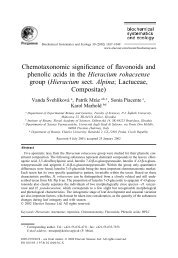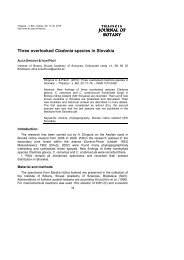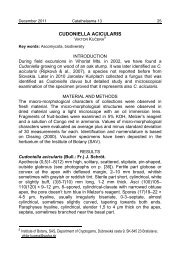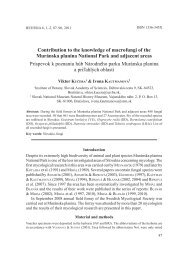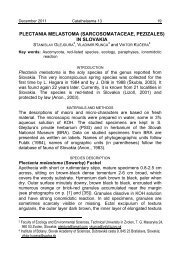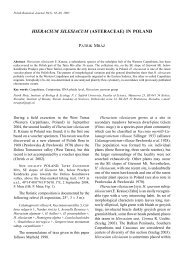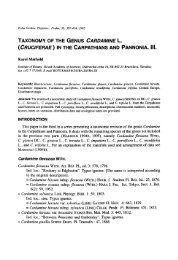Typification of the Linnaean names of the genus - institute of botany ...
Typification of the Linnaean names of the genus - institute of botany ...
Typification of the Linnaean names of the genus - institute of botany ...
Create successful ePaper yourself
Turn your PDF publications into a flip-book with our unique Google optimized e-Paper software.
LINNAEAN NAMES OF THE GENUS CARDAMINE<br />
reference to Hermann’s Paradisi batavi prodromus (“P. B. P.”), by <strong>the</strong> note “Hort. Reg.<br />
Hampton[iens.]. collegimus” and by <strong>the</strong> illustration in Phytographia. There is a specimen<br />
in <strong>the</strong> Sloane herbarium in BM (97:19, left-hand plant) upon which <strong>the</strong> illustration<br />
is most probably based. Ray in his Supplementum (1704) refers to Hermann’s Paradisi<br />
batavi prodromus (1689) and Paradisus batavus (1698) as well as to Plukenet’s Phytographia<br />
(1691) and Almagestum botanicum (1696). Fur<strong>the</strong>rmore he repeats verbatim <strong>the</strong> whole<br />
written entry from Hermann’s Paradisus batavus (1698: 202).<br />
Cardamine amara L., Species plantarum: 656, 1753. - LT (designated by Khatri, 1989: 92):<br />
LINN 835.17<br />
The protologue (Linnaeus, 1753: 656) has <strong>the</strong> following elements:<br />
12. CARDAMINE foliis pinnatis, axillis stoloniferis. It.<br />
W:goth. 76.*<br />
Cardamine foliis pinnatis, foliolis subrotundis angulosis. Hall.<br />
helv. 558, Fl. suec. 560. Dalib. paris. 199.<br />
Nasturtium aquaticum majus & amarum. Bauh. pin. 104.<br />
Habitat in Europae septentrionalioris nemoribus.<br />
The diagnostic phrase name is referred directly to Linnaeus’s Wästgöta-Resa [tour in<br />
West Gothland] (1747b). Linnaeus considered <strong>the</strong> description (or descriptions) in this<br />
work as particularly good since he marked <strong>the</strong> reference with an asterisk (cf. Stearn,<br />
1957: 162). The references to this taxon in Wästgöta-Resa, are indicated by <strong>the</strong><br />
abbreviation from <strong>the</strong> first edition <strong>of</strong> Linnaeus’s Flora suecica (1745) “Flor. 560”.<br />
During his tour in West Gothland Linnaeus apparently found this taxon in two<br />
places, namely Kinnekulle (mentioned on <strong>the</strong> p. 26 as “CARDAMINE Nasturtium<br />
amarum dicta” and “CARDAMINE foliis pinnatis ex summis alis stolonibus<br />
reptans”), and Mossebarg (mentioned on p. 76 as “CARDAMINE foliis pinnatis:<br />
foliolis subrotundo angulosis”). In connection with <strong>the</strong> occurrence in Kinnekulle,<br />
Linnaeus provided ra<strong>the</strong>r detailed information written in Swedish. The specimen in<br />
<strong>the</strong> <strong>Linnaean</strong> herbarium in London (LINN), no. 835.17, selected by Khatri (1989) as<br />
a lectotype <strong>of</strong> this name, is <strong>the</strong> only known one with <strong>the</strong> epi<strong>the</strong>t “amara” written in<br />
Linnaeus’s hand. This inscription at <strong>the</strong> bottom <strong>of</strong> <strong>the</strong> sheet is accompanied by <strong>the</strong><br />
number “12”, which is <strong>the</strong> species number from Species plantarum. This is usually<br />
considered to be a strong indication that <strong>the</strong> specimen was in Linnaeus’s possession<br />
by 1753 (Jarvis, 1992: 506) and <strong>the</strong>re is a high probability that this specimen was<br />
collected at one <strong>of</strong> <strong>the</strong> localities referred to in ei<strong>the</strong>r Wästgöta-Resa (1747b) or Flora<br />
suecica (1745). Indeed, <strong>the</strong> populations occurring in nor<strong>the</strong>rn Europe are diploid and<br />
are considered to belong to <strong>the</strong> typical subspecies <strong>of</strong> C. amara.<br />
It is interesting that <strong>the</strong>re is ano<strong>the</strong>r fragmentary specimen, although not original<br />
material <strong>of</strong> Cardamine amara, but taxonomically referable to this name, bearing<br />
inscriptions “7 chelidonia” (probably by Linnaeus filius) at <strong>the</strong> bottom <strong>of</strong> <strong>the</strong> sheet and<br />
“Finlandia” (by Linnaeus) on <strong>the</strong> reverse in <strong>the</strong> <strong>Linnaean</strong> herbarium in Stockholm<br />
(S) (see below).<br />
The polynomial “CARDAMINE foliis pinnatis pinnis subrotundis angulosis” in<br />
Haller’s Enumeratio methodica stirpium Helvetiae (1742) is accompanied by reference to<br />
five localities in Switzerland, namely Berna [Bern], Tigurum [Zürich], Neocomum<br />
[Neuchâtel], Lenz, and Brienz. The identification <strong>of</strong> this element is less straightforward,<br />
because <strong>of</strong> <strong>the</strong> occurrence <strong>of</strong> tetraploid populations <strong>of</strong> C. amara in this area,<br />
which might represent a new, as yet undescribed taxon (Marhold, 1992, 1995a; Jalas<br />
113



